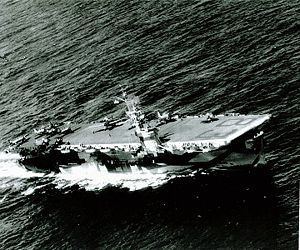Name USS Sargent Bay Commissioned 9 March 1944 Struck 27 June 1958 Launched 31 January 1944 Builder Kaiser Shipyards | Laid down 8 November 1943 Decommissioned 23 June 1946 Construction started 8 November 1943 Length 156 m | |
 | ||
Fate Sold for scrap on 30 July 1959 Part of United States Pacific Fleet (1944–1946) Operations Battle of Iwo Jima, Battle of Okinawa | ||
Escort carrier USS Sargent Bay (CVE-83), originally classified AVG-83, was reclassified ACV-83 on 20 August 1942, allocated to the United Kingdom under Lend Lease on 11 November, reallocated to the United States on 21 June 1943, reclassified CVE-83 on 15 July. laid down on 8 November 1943 by the Kaiser Shipbuilding Company of Vancouver, Washington under Maritime Commission contract (MC hull 1120), launched on 31 January 1944 sponsored by Mrs. Edith W. DeBaun, and commissioned on 9 March 1944, Captain William Theodore Rassieur in command.
Contents
Service history
Following shakedown, Sargent Bay completed a ferry trip to Saipan, carrying P-47 Thunderbolts of the 333rd Fighter Squadron, 318th Fighter Group. The squadron's aircraft were catapulted from her deck on 18 July, after which she reported to the 3rd Fleet at Pearl Harbor on 17 August. The following day, she sailed for Eniwetok and Manus Island, and on 6 November, departed the latter for the first of four tours of duty with underway replenishment groups off the Philippines. While the carrier's aircraft patrolled overhead, the other units of the replenishment groups provided fuel and replacement aircraft to the fast carriers, enabling them to remain at sea for extended periods. Later based at Ulithi, Sargent Bay remained on this duty until 27 January 1945, with individual tours at sea lasting from two to four weeks.
In February 1945, Sargent Bay undertook a new assignment and arrived off Iwo Jima on the 16th to provide air support for the landings there. Her aircraft flew artillery spotting and ground support missions, and anti-aircraft and anti-submarine patrols until the ship departed Iwo Jima on 11 March. On 16 March, Captain Rassieur was relieved by Captain Richard Maxey Oliver. She provided similar support during the Okinawa campaign from 25 March - 20 June, with time out only for a period in support of the Logistics Support Group from 7–18 April and for repairs at Guam from 15 May -2 June. The ship arrived off Leyte on 23 June for a month of upkeep, and then sailed for overhaul in the United States, arriving at San Pedro, California, on 9 August.
On completion of repairs, Sargent Bay was assigned to "Magic Carpet" duty. She made two trips bringing troops from Hawaii in October, and two more in November and December from Eniwetok and Okinawa. She arrived at Boston, Mass., for inactivation on 23 March 1946. On 28 March, Captain Oliver was relieved by Commander Milton S. Worley, and Sargent Bay was decommissioned and placed in reserve there on 23 July.
Sargent Bay was reclassified CVU-83 on 12 June 1955. She was struck from the Naval Vessel Register on 27 June 1958, sold on 30 July 1959 to the J. C. Berkwitt Co. and scrapped at Antwerp, Belgium, in September 1959.
Awards
Sargent Bay received six battle stars for her World War II service.
